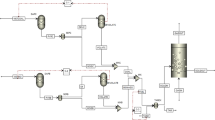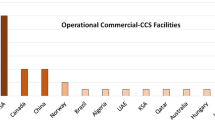Abstract
Oxy fuel combustion and conventional cycle (currently working cycle) in Kazeroon plant are modeled using commercial thermodynamic modeling software. Economic evaluation of the two models regarding the resources of transport and injection of carbon dioxide into oil fields at Gachsaran for enhanced oil recovery in the various oil price indices is conducted and indices net present value (NPV) and internal rate of return on investment (IRR) are calculated. The results of the two models reveal that gross efficiency of the oxy fuel cycle is more than reference cycle (62% compared to 49.03%), but the net efficiency is less (41.85% compared to 47.92%) because of the high-energy consumption of the components, particularly air separation unit (ASU) in the oxy fuel cycle. In this model, pure carbon dioxide with pressure of 20×105 Pa and purity of 96.84% was captured. NO X emissions also decrease by 4289.7 tons per year due to separation of nitrogen in ASU. In this model, none of the components of oxy fuel cycle is a major engineering challenge. With increasing oil price, economic justification of oxy fuel combustion model increases. With the price of oil at $ 80 per barrel in mind and $ 31 per ton fines for emissions of carbon dioxide in the atmosphere, IRR is the same for both models.
Similar content being viewed by others
References
[1]Parsons Brinckerhoff and the Global CCS Institute. Accelerating the Uptake of ia]CCS: Industrial Use of Captured Carbon Dioxide [R]. March 2011.
FIGUEROA J D, FOUT T, PLASYNSKI S, MCLLVRIED H, SRIVASTAVA R D. Advances in CO2 capture technology [R]. The U.S. Department of Energy’s carbon sequestration program. Greenhouse Gas Control, 2008.
Gielen D. The future role of CO2 capture and storage: results of the IEA-ETP Model [R]. Paris, France: International Energy Agency, 2003 EET/2003/04.
BLOMENA E, HENDRIKSA C, NEELEB P. Capture technologies: Improvements and Promising Developments [J]. Energy Procedia, 2009, 1(1): 1505–1512.
WALL T, GUPTA R, BUHRE B, KHARE S. Oxy-fuel (O2/CO2, O2/RFG) technology for sequestration-ready CO2 and emission compliance [C]// The 30th International Technical Conference on Coal Utilization & Fuel Systems, Coal Technology, Clearwater, FL, USA, 2005.
Cryogenic Air Separation; History and Technological Progress [R]. The Linde AG Engineering Division, Dr.-Carl-von-Linde-Str. 6–14, 82049 Pullach, Germany, 2007.
BUHRE P, ELLIOTT L, SHENG C, GUPTA R, WALL T. Oxy-fuel combustion technology for coal-fired power generation [J]. Progress in Energy and Combustion 2008, 31(4): 283–307.
Position Paper for the Structuring of the Asset Sale of Khoy and Zargan Power Plants [R]. Ghods Niroo Consulting Engineers Privatisation of Power Stations/Iran; April 2003.
THOMAS S. Enhanced Oil Recovery. An Overview [J]. Oil & Gas Science and Technology, 2008, 63(1): 9–19.
EKSTRÖM C, SCHWENDIG F, BIEDE O, FRANCO F. HAUPT G, de KOEIJER G, PAPAPAVLOU C, ROKKE P. Techno-economic evaluations and benchmarking of pre-combustion CO2 capture and oxy-fuel processes developed in the european encap project [J]. Energy Procedia, 2009, 1(1): 4233–4240.
STEIN-BRZOZOWSKA G, MAIER J, SCHEFFKNECHT G. Impact of the oxy-fuel combustion on the corrosion behavior of advanced austenitic superheater materials [J]. Energy Procedia, 2011, 4: 2035–2042.
CORAGGIO G, TOGNOTTI L, CUMBO D, ROSSI N, BRUNETTI J. Retrofitting oxy-fuel technology in a semi-industrial plant: Flame characteristics and NOX production from a low NOX burner fed with natural gas [J]. Proceedings of the Combustion Institute, 2011, 33(2): 3423–3430.
BURDYNY T, STRUCHTRUP H. Hybrid membrane/cryogenic separation of oxygen from air for use in the oxy-fuel process [J]. Energy, 2010, 35(5): 1884–1897.
Author information
Authors and Affiliations
Corresponding author
Rights and permissions
About this article
Cite this article
Torabnejad, E., Haghighi-Khoshkhoo, R. & Sarabchi, N. Thermo economic evaluation of oxy fuel combustion cycle in Kazeroon power plant considering enhanced oil recovery revenues. J. Cent. South Univ. 21, 1025–1033 (2014). https://doi.org/10.1007/s11771-014-2033-1
Received:
Accepted:
Published:
Issue Date:
DOI: https://doi.org/10.1007/s11771-014-2033-1




